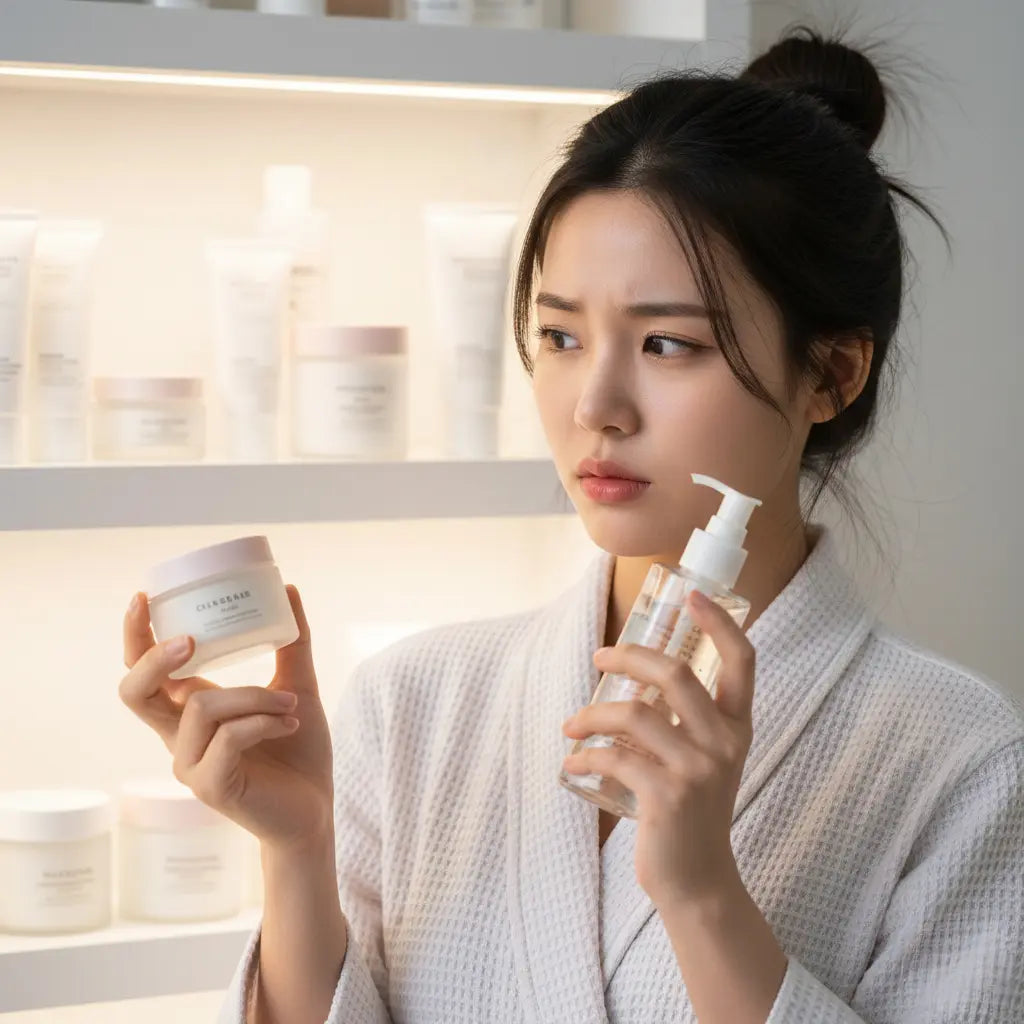Why Your First Cleanser Choice Matters More Than You Think
Choosing the right first cleanser determines how effectively you remove makeup, sunscreen, and excess sebum without stripping your skin barrier; when this step is done well, every product that follows—essences, serums, and moisturizers—performs better.
What Is a Cleansing Balm?
A cleansing balm is a solid-to-oil formula that melts on contact with skin, dissolves makeup through gentle massage, and turns milky upon emulsification with water, rinsing away to leave skin soft and comfortable.
Rich butters and nourishing oils often feature in balms, and many add supportive ingredients like ceramides, vitamin E, or centella to cushion sensitive or dry skin during cleansing.
Balms are ideal if you wear heavy or waterproof makeup, prefer a no-drip application, or travel frequently since the solid format is spill-proof and carry-on friendly.

What Is a Cleansing Oil?
A cleansing oil is a lightweight liquid in a pump that spreads quickly on dry skin, breaks down sunscreen and long-wear formulas within seconds, and emulsifies with a splash of water to rinse clean without greasy residue.
Formulations commonly combine skin-friendly oils (like jojoba, sunflower, or rice bran) with gentle emulsifiers and botanical extracts for clarity and balance.
Oils are a smart choice for oily or combination skin, sunscreen-only days, and anyone wanting a fast, hygienic cleanse from a pump bottle.
Balm vs. Oil: How Do They Really Differ?
A balm offers a cushiony, indulgent massage that feels comforting and controlled, making it perfect for heavy makeup and drier complexions; an oil spreads instantly, prioritizing speed, lightness, and a clean rinse that suits oilier skin types and busy routines.
After rinsing, balms typically leave skin soft and nourished, while oils tend to feel freshly cleansed and weightless; at night, most complexions benefit from following either option with a gentle water-based second cleanse.
For travel, the solid format of balms prevents leaks, whereas oils may require a sealed travel size; both, however, are excellent first steps when properly emulsified and thoroughly rinsed.
Which Should You Choose for Your Skin Type?
If your skin is dry, dehydrated, or mature, a balm’s richer cushion and barrier-supporting ingredients generally feel more comfortable and help reduce post-cleanse tightness.
If your skin is oily, combination, or breakout-prone, a lightweight oil that emulsifies cleanly can dissolve excess sebum efficiently without heaviness or pore-clogging when followed by a water-based cleanse.
If your skin is sensitive or easily reactive, fragrance-free balms with soothing agents (such as centella or allantoin) minimize friction and help keep the barrier calm during cleansing.
For combination skin, it’s practical to switch seasonally: a swift, airy oil in hot and humid months, and a cocooning balm when the air turns cold and dry.

How to Use a Cleansing Balm (The Right Way)
Begin with dry hands and a dry face, scoop a nickel-sized amount, warm it between your fingers for a few seconds, and massage in gentle circular motions for about a minute before emulsifying with water until the texture turns milky and then rinsing thoroughly; follow with a water-based cleanser at night.
How to Use a Cleansing Oil (The Right Way)
On dry skin, dispense two to three pumps, spread evenly over face including lips and eyes, massage for 30–60 seconds, add a little water to emulsify, and rinse clean; at night, complete the double cleanse with a gentle gel or foam.

Common Mistakes to Avoid
Do not start on wet skin because water blocks oil from binding to makeup and sunscreen; always emulsify before rinsing so you don’t leave a film; and avoid harsh rubbing—let the oil do the work while you keep motions light and patient.
At night, skipping the water-based second cleanse can lead to residue, while using too much product wastes formula and makes rinsing harder; the goal is clean but never tight skin.
So… Balm or Oil?
There is no universal winner because both are excellent when matched to your skin and lifestyle: choose a balm for comfort, heavy makeup, and dry seasons, and choose an oil for speed, lightness, sunscreen days, and oilier complexions.
If you can, keep one of each and rotate with the weather and your daily needs; what matters most is consistent, thorough, and gentle cleansing that respects your barrier.
[ FAQ ]
Do oil-based cleansers cause breakouts?
When properly emulsified and followed by a water-based cleanse, they are unlikely to clog pores; choose lightweight, non-comedogenic options for oily or acne-prone skin.
Do I need to double cleanse in the morning?
Usually not; mornings typically need only a single gentle water-based cleanser, while double cleansing shines at night.
Are balms safe around the eyes?
Most are gentle enough, but very sensitive eyes may prefer using a dedicated eye makeup remover first.
The best cleanser is the one you will use consistently and correctly; listen to your skin, keep the technique gentle, and your barrier will reward you with a calmer, clearer complexion.
your perfect first cleanse is just one routine away.



